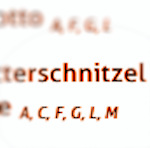
Whether you’re in an exclusive restaurant or snatching a quick sausage from a late-night stall, you may see one or more capital letters or numbers next to the food and dishes written on menus or display boards. Why?
- Allergen codes mandated by EU food safety laws
- Not always listed (outlets can opt to provide the same information verbally, for example)
- See also:
Allergy information

(The ubiquitous Schnitzel)
Here’s a sample menu entry for a pork Wiener Schnitzel and a side salad:

So what’s this all about? C, G, A? L, M, O?
Fortunately, the letters aren’t some obscure coded message designed to confuse foreigners. They actually serve a useful purpose.
Each capital letter simply stands for a particular ingredient found in that food or dish. Not just any ingredient, but “substances or products causing allergies or intolerances”.
EU law demands the communication of this allergy information to ensure, for example, you don’t find your meal or holiday ruined by an unfortunate reaction.
Here’s the list of allergens and similar substances typically used in Viennese establishments:
- A (Cereals containing gluten)
- B (Crustaceans)
- C (Eggs)
- D (Fish)
- E (Peanuts)
- F (Soja)
- G (Milk and/or lactose)
- H (Nuts)
- L (Celery)
- M (Mustard)
- N (Sesame seed)
- O (Sulphur dioxide and sulphites)
- P (Lupins)
- R (Molluscs)
The list corresponds to the 14 categories given in Annex 2 of the EU’s regulation (#1169/2011) covering the provision of food information to consumers.
If you have food allergies or intolerances, check the EU’s food information legislation page to find fuller details of what each category does and does not cover.

(Hazelnuts, walnuts and cashews come under code H)
So our Schnitzel (C, G, A) from the menu listing above might include eggs, dairy, and gluten, while the side salad (L, M, O) might include celery, mustard, and sulphites.
Sometimes you find numbers instead of letters: whatever code is used, the corresponding key should be available somewhere.
Many outlets choose to include the codes in the menu itself; hence all those letters in our example. (Though most tend to be a little bit more subtle in their presentation.)
No capital letters or numbers at all on menus does not, however, usually mean the allergens are absent: the location likely decided to communicate the required information in another way.
In such cases, look for the allergy information posted on the wall or above the counter. Or the outlet may have trained its staff to clarify what’s in what if asked.
If a restaurant, bar or similar chooses the talk-to-the-staff option, then they must make it clear somewhere that you can ask for this information.
Note that the allergen information may be absent if it’s blatantly obvious.
For example, a restaurant need not indicate that your egg salad with mustard dressing contains egg and mustard: the clue is in the name.